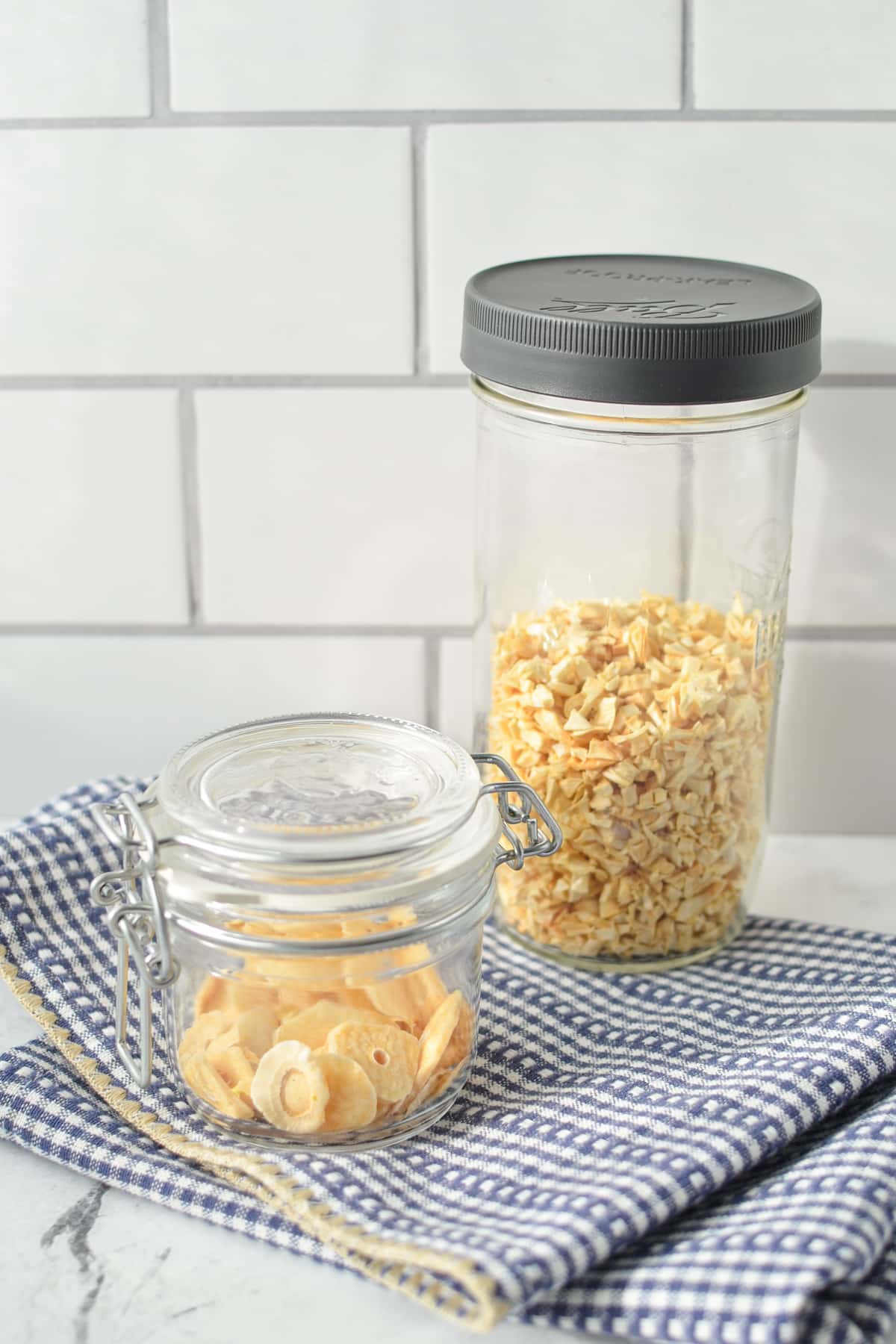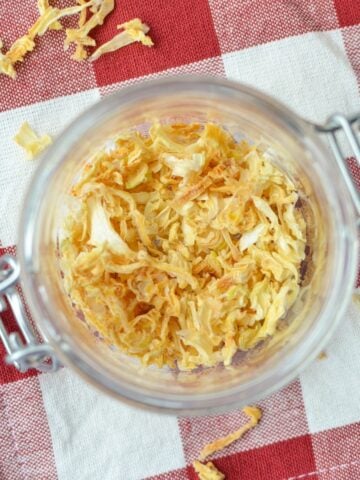If you have lots of fresh garlic on hand, you may be wondering if you can dehydrate garlic. The answer is yes! Not only can you make garlic powder after dehydrating garlic, but minced garlic can be dried and added to soups and stews throughout the year.

Many years back when I was still living in a 600 square foot apartment, I had a dream. It was to live out in the country with enough land to raise animals, gardens, and pursue the homesteading dream. The problem was that I had no land to speak of. So I set about learning the skills that I would someday need in order to preserve a harvest from a garden.
Those skills included canning, fermenting, and of course: dehydrating.
Dehydrating your own food is easy, fun to do, and a great way to preserve the harvest with minimal prep work. Best of all? The dried goods can be stored at room temperature in your pantry. This means you don't need to find room in the fridge like you do for ferments, or heat up the kitchen like with canning.
Do you see why it's such a great food preservation method?
Dehydrating garlic is a great way to preserve the flavor and scent of fresh garlic. You can even make your own garlic powder by grinding the dried garlic pieces. Make sure to check out my posts for dehydrating onion (and making onion powder), as well as dehydrating shallots. These are all great dried foods to add to your pantry shelf. They can all be made into powders for an easy way to add them to your favorite recipes.
Why Dehydrate Garlic?
- A great way to preserve a bumper crop or a Farmer's market find!
- Tastes WAY better and fresher than anything you would purchase at the grocery store.
- You can customize how you want the garlic to be dried - sliced, minced, or ground into flavorful garlic powder.
- Easy to make using either a dehydrator or a low temperature oven.
Ingredients + Equipment

- Garlic: I recommend using the freshest garlic you can find, as those pesky green sprouts actually create a bitter flavor. They can easily be removed, but it's much easier to have fresh garlic to start with. Use some that you have grown your own, or pick some up at the Farmer's market or bulk food store.
Equipment:
- Dehydrator: While a dehydrator isn't absolutely needed to make dried garlic, it is highly recommended. Especially since an oven can use more electricity, it's important to invest in a dehydrator if you plan on drying a lot of food. It also preserves more of the nutrition when compared to the higher heat of the oven. I'm upgrading to this Excalibur model, which is the Cadillac of dehydrators.
- Garlic peeler (optional): You can definitely peel the garlic all by hand, but I was seriously impressed with these silicone garlic peelers. I'm not one for single-use kitchen gadgets, but considering this was so cheap and it worked so well it's earned a spot in my kitchen drawer.
Peeling and Preparing the Garlic
Before you start filling the dehydrator trays (or sheet pans for the oven), there is one thing you need to take care of: peeling and prepping.
Garlic can be a total pain to peel, but I actually purchased this cool silicone garlic peeler and I have to say I was impressed! And you can get a 3-pack for less than $10, which is definitely worth it in my opinion.
You just stick a few cloves of a similar size into the tube, then roll on the counter using the firm part of your palm. Then they come out with 99% of the peel removed. It's such a time saver!

If you don't want to pick up a garlic peeler, you can use a knife instead. Cut the root end off of each clove and gently press on it with the side of the knife, and then carefully remove the peel with your fingers.
COOK'S TIP: If you have some older garlic with a green sprout in the middle, simply cut the clove in half and pull the green sprout out. Then mince or chop the garlic clove as desired.
Slicing and Mincing the Garlic
Once all of your garlic cloves are peeled, you're ready to slice OR mince them. Minced garlic cloves work really well for adding to liquid-heavy foods. Minced works best in recipes that will cook for at least 30 minutes (to hydrate the garlic). While sliced garlic cloves are a simple way to prep those that you want to turn into homemade garlic powder. .

I like to do a mix of both. That way I have some for adding to my favorite meals in lieu of fresh, as well as some to turn into the best garlic powder EVER.
How to Dehydrate Garlic
Once all of the garlic has been sliced (or minced), add them to dehydrator trays. If your model has fine mesh screens, you can place them right on the tray. If yours has large holes (like mine), try lining them with parchment paper cut to size OR silicone dehydrator liners.
Spread the minced or sliced garlic out in a single, even layer, ensuring that the pieces do not touch whenever possible. This gives the best air flow, and will help them dry more quickly and evenly.

Insert the trays into the dehydrator (oven instructions are below if you don't have one), spacing them out evenly.

Set the temperature to 125ºF (52ºC) and close the door. Dry the garlic cloves for 6-12 hours, or until they are brittle and break in half easily.
Minced garlic will be done before sliced garlic. It is dry when brittle, very hard, and cannot be impressed with a fingernail.

Allowing to Cool
Once the garlic has been throughly dried, allow it to cool completely to room temperature. This can be done by leaving the trays in the (turned off and unplugged) dehydrator overnight, or removing the trays to the countertop and allowing to cool for an hour or so.
This is done to ensure they are completely dry and to avoid condensation that occurs from placing warm foods in a container or jar.
Conditioning Dehydrated Garlic
After you dehydrate garlic, as a best practice you should also take an extra step that is known as conditioning. This is something I recommend for all of my dehydrator recipes, as it shows whether the food is adequately dry for storage AND redistributes the moisture evenly between the pieces.
Conditioning is easy to do. Just add your (cooled) dehydrated food to a glass jar fitted with a lid and place in a visible spot in your kitchen for about 24 hours. Make sure to place it outside of direct sunlight, as the sun can cause the jar to warm up and create condensation.

Shake the jar a few times as you think of it through the 24 hour period. If there is no condensation or fogging during that time, you're good to transfer your dehydrated garlic to storage!
If there is condensation or fog during that time, simple return the garlic to the dehydrator (or low temperature oven) and dry it until brittle, cool, and repeat the conditioning step.
Storage Tips
- Once your dried garlic is completely cool and conditioned, transfer it to airtight containers or glass jars with lids to store for 6-12 months.
- Discard if there are any signs of spoilage such as moisture in the jar, foggy glass, condensation, or mold growth.
- For extended storage, transfer your dehydrated garlic to mylar bags with oxygen absorbers, OR glass jars that have been vacuum sealed with a jar attachment.
- Once ground into garlic powder, your dehydrated garlic will last about 2-6 months, with some clumping being considered normal.
- For the best results, grind only as much garlic powder as you will use in 2 months and store the remaining dried garlic in its whole form. Then grind in batches as needed.


Oven Instructions
If you do not have a dehydrator, you can still make dried garlic by using the lowest setting on your oven (about 140-150ºF). You may need to check your manual or call your manufacturer to find out how to configure the settings.
Adjusting the recipe for making in a low temperature oven:
- Set your oven on the lowest temperature (about 140-150ºF/60-65ºC).
- Spread the garlic onto parchment-lined baking sheets in a single layer, spacing the pieces evenly and sparsely.
- Dry for 4-8 hours, rotating the sheets several times to ensure even drying.
- Once the pieces are brittle and break easily, remove them from the oven and allow to cool to room temperature.
- Transfer the cooled garlic pieces to a jar for conditioning.
- After 24 hours, if no condensation or fogging has occurred, transfer to storage or grind into garlic powder.
Making Garlic Powder
For detailed information on how to make garlic powder, be sure to check out the post I dedicated to it. The post includes lots of information on how to store your garlic powder, and specifics on the process. I'll give you the rundown so you have a general idea.
Basically, once your garlic is dried and has passed the conditioning test, you're going to add it to a clean coffee or spice grinder. I have one that I keep specifically for the purpose of making homemade powders. I suggest you do the same - no one wants a garlic powder infused cup of coffee!


Working in batches, grind the garlic pieces or slices into a powder by holding the grinder down or pulsing until the desired texture is reached. I like mine super fine, as that's the closet to store-bought garlic powder.
Transfer your homemade garlic powder to an airtight container and store for about 2-6 months. Note that you will get some clumping, and that's pretty normal with both homemade and store-bought garlic powder.
PRO TIP: If you want to have the freshest garlic powder year round, I recommend grinding just enough that you will use in 2 months. Leave the remaining dried garlic whole until needed. Then take out the spice grinder and grind in small batches throughout the year.
Different Ways to Dehydrate Garlic
Making Dehydrated Garlic Flakes
- To make dehydrated garlic flakes, simply mince the garlic before dehydrating. If you can, get thinner, wider pieces as opposed to a typical small square shape.
- Dehydrate at 125ºF (52ºC) for 6-12 hours, or until the pieces are hard, dry, and not able to be pierced with a fingernail.
- Allow the garlic flakes to cool, then transfer to a glass jar or container with a lid for conditioning.
- Once the garlic flakes have been conditioned, transfer to long term storage or use in your favorite recipes.
Dehydrating Garlic Cloves
- While whole cloves of garlic can be dehydrated, they take an exceptionally long time and it can be unpredictable when it comes to knowing whether the insides are completely dried.
- Instead, if you want to dehydrate whole cloves it is recommended to freeze dry them.
Dehydrated Garlic Chips
- Slice each peeled garlic clove into ⅛" slices and place on dehydrator trays.
- Dry for 6-12 hours, or until the slices are crisp and break easily when pressured.
- Allow the slices to cool, then place in a jar for conditioning.
- Once the garlic has been conditioned, transfer to long term storage or use in your favorite recipes (or as a snack!).

Dehydrated Garlic vs. Garlic Powder
While garlic powder can easily be made from dehydrated garlic, the two aren't the same and they can't be used interchangeably. The biggest difference in how they are used in a recipe.
- Dehydrated garlic is used to substitute fresh minced garlic, using about ½ teaspoon of dried garlic flakes for every garlic clove used in a recipe.
- Dehydrated garlic also must be used in a recipe that has a good amount of liquid in order for the dried garlic to rehydrate and soften - for this reason a longer cook time is often recommended.
- Garlic powder, on the other hand, can be used in a variety of recipes, including those without liquid or those that will not be cooked. Garlic powder is also more concentrated, with approximately ⅛th of a teaspoon of garlic powder being equivalent to one clove.
- Garlic powder is easy to use for seasoning meats, preparing a rub, or even to use in your own homemade seasoning mixes (like seasoned salt or taco seasoning).
Dehydrated Garlic and Garlic Powder Conversion
½ teaspoon dried minced garlic = 1 clove fresh garlic
⅛ teaspoon garlic powder = 1 clove fresh garlic
½ teaspoon dried minced garlic = ⅛ teaspoon garlic powder
Frequently Asked Questions
The best way to dehydrate garlic is sliced into ⅛" slices and in a dehydrator set to 125ºF (52ºC). Dry for 6-12 hours, or until dry and brittle, breaking easily with your hand. Alternatively, you can dry them in an oven set to 140-150ºF (60-85ºC) for 4-8 hours.
Dehydrated garlic should last anywhere from 6-12 months when stored in an airtight container, so long as the additional step of conditioning has been done as well. For longer storage, transfer your dehydrated garlic to mylar bags with oxygen absorbers, OR mason jars that have been vacuum sealed with a jar attachment.
It is not recommended to dehydrate whole cloves, as it is unpredictable and hard to know when the centers will be completely dried through. For this reason it's recommended to dry your garlic in slices or minced. If you want to dehydrate whole cloves, a freeze dryer is recommended instead.
You can choose to slice or mince garlic, based on what your desired outcome is. Slicing the garlic is a bit easier, although it takes longer. Sliced garlic is perfect for making garlic powder. Minced garlic takes longer to prepare, but dehydrates more quickly and is easier to use in recipes as it does not need to be ground to a powder.
When stored properly and made at home, dehydrated garlic is a good substitute for fresh. Although fresh is best, a good quality dehydrated garlic can preserve a lot of flavor. For the best results, use within the first 2 months of dehydrating.
More Dehydrating Recipes
- Dehydrating onions
- Dehydrating shallots
- How to make garlic powder
- How to make onion powder
- Drying basil
📖 Recipe

Dehydrating Garlic
Equipment
- Dehydrator (or oven)
Ingredients
- Garlic
Instructions
- To get started, ensure the peeling is removed from each of the garlic cloves you are preparing.
- If dehydrating garlic for use in cooked foods, mince the garlic with a sharp knife. If you are dehydrating it for the purpose of grinding it into garlic powder, cut the cloves into thin slices.
- If your dehydrator does not have fine mesh screens, line the trays with parchment paper or silicone dehydrator liners.
- Place the garlic in an even layer on each tray, ensuring that there is ample room for the air to flow around each piece. For slices, ensure the slices do not touch. For minced garlic, spread it with your hands in a sparse, even layer.
- Set the dehydrator to 125ºF (52ºC) and place each of the filled trays into the dehydrator.
- Dry for 6-12 hours, or until all of the pieces are brittle and break easily. Humid environments will take longer than dryer environments, so using the break test is the most reliable.
- Turn off the dehydrator and allow the slices or minced garlic to completely cool in the dehydrator, or remove the trays to the open air to cool for an hour.
- Once the garlic is completely cooled to room temperature, transfer it to a glass jar with a lid for conditioning - this checks for excess moisture.
- Place the glass jar in a visible location for 24 hours, shaking it a few times throughout. Do not place it in direct sunlight, as the heat can cause a greenhouse effect that will cause moisture to build in the jar.
- If any condensation or fogging shows in the jar, return your food to the dehydrator and dry again until it is brittle and passes the conditioning test.
If your food passes the conditioning test, transfer it to airtight jars or containers (or mylar bags) for storage. Store for 4-12 months, discarding if there are any signs of spoilage. - For garlic powder: Add the completely dried garlic slices (or minced garlic) to a spice or coffee grinder reserved for the purpose of grinding spices and powders. Grind until it is broken down into a fine powder. Then transfer to an airtight jar or container to store for 2-6 months.
Notes
Please note that some of my blog posts here at Little Home in the Making may contain affiliate links. If you make a purchase through these links, I will get a small commission at no additional cost to you. See our disclaimer for more information.




















Elina Brooks
I found it helpful when you told us that we can easily make garlic powder if we have dehydrated garlic and a grinder to use for the process. I manage a family restaurant, and I was thinking of making my own garlic powder for the food on our menu from now on. I'll take note of this while I look for a food supplier to contact for bulk dehydrated garlic soon.